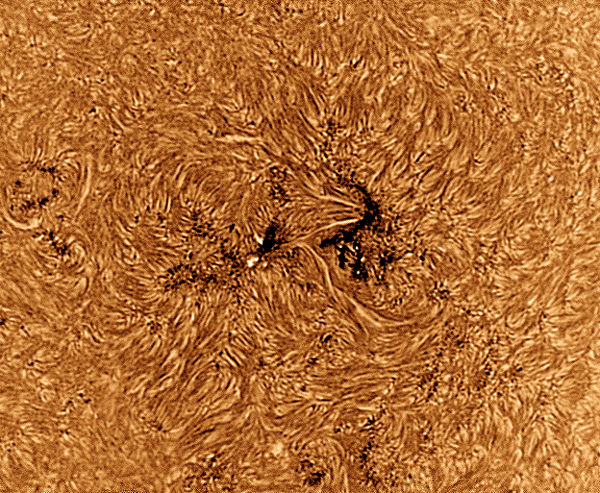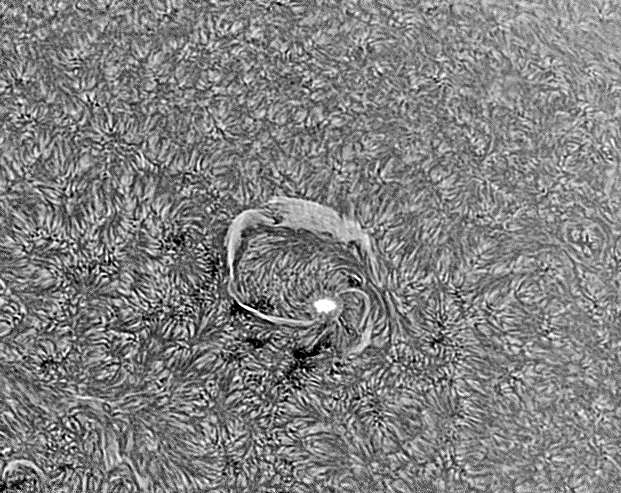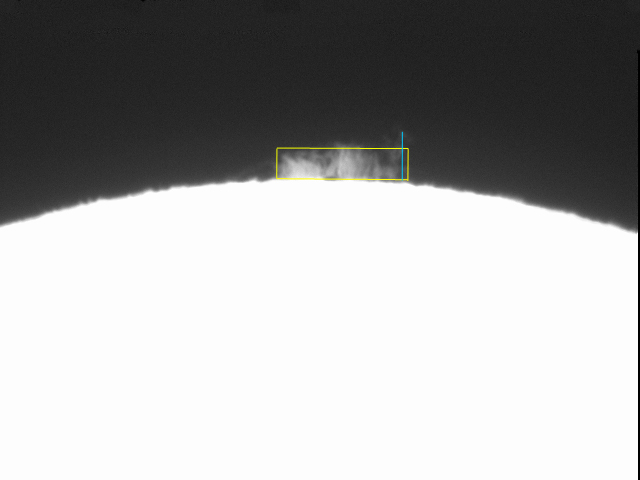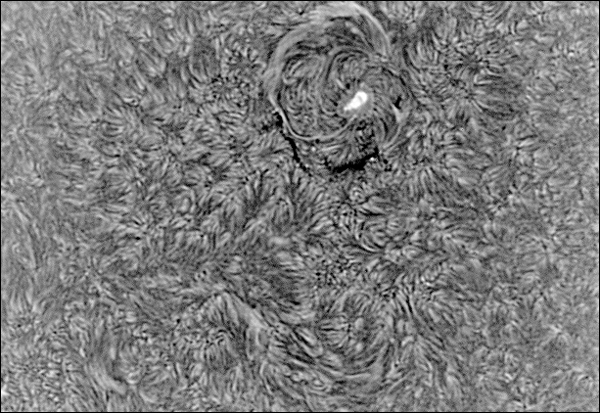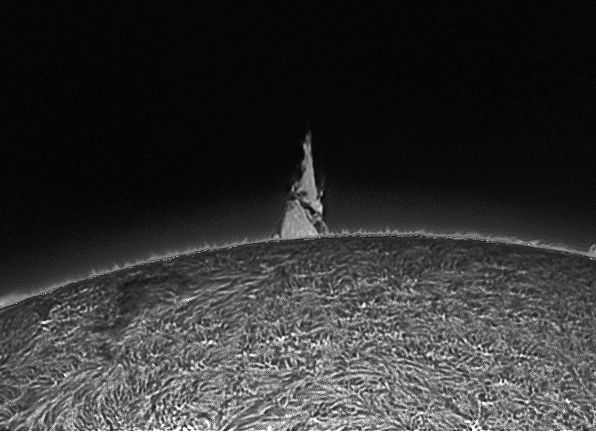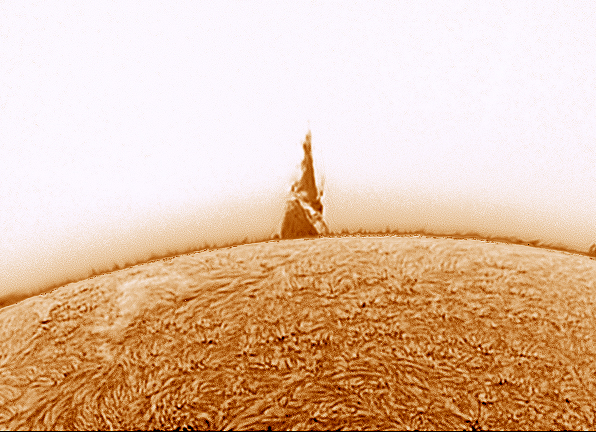These are a few prominence today on the Sun
Latest upgrade.. Thunderbolt Drive!
My latest toy! I use Macbook Pro for all my computing need.. Apple introduced Thunderbolt Port with the capability of.. well.. lighting speed of data transfer. I always wanted to have a Thunderbolt external drive and now, I have one. LaCie d2 USB3 & Thunderbolt 3 TB Drive.
With the raw uncompressed AVI files i shoot for Sun, Moon and planets, my laptop's hard disk always complain of low storage. Though i have 750 GB HD, it still way too low to save those massive AVI files.
To give you an idea, today's 1 minute and 50 seconds AVI file had a size of 2 GB! Now this is for the Sun where i had to keep the acquisition time very small so the ever changing Sun's surface does not get blurred. But when i shoot the moon, i can go upto many many minutes of recording and the single file can be of 40-50 GB in size.. yes you read that right.. no type here.
Now imagine transferring all this data to the external drives.. i had to leave the computer on for over the night transfers.
Enter the world of Thunderbolt technology: My laptop has 12 GB RAM and the built-in hard disk has 5400 rpm. Following is the test result of the built in Macbook Pro (4 cores 2.4 Ghz i7 processor) hard disk.
Write and read speed is around 50 MB/s and 60 MB/s. Now see how thunderbolt external drive is doing in this test.
Look at those speeds.. a whopping 166.5 MB/s write and 169.7 MB/s read speed.. WOW!
This is great.. just great!!
Prominence on 2 July 2013
Here is an other beautiful prominence on the solar limb today.. Truly sun is on fire!
Nice prominence on 1st July 2013
I am not very happy with the processing of this image since i lost some very dim details in the prominence while coloring it in photoshop.. but this is the best i could do with it so far. This is a combined image of two separate high and low exposures of the same area of the Sun and this way i was able to capture both the very faint prominence and the bright solar disk.
I like the B/W image much more than the colored image here. What i have found, during my astronomical imaging routines is that every image is different in terms of processing. I really feel the need to make AVI with at least three exposure/gain/brightness etc settings to do the justice for bringing out details. I would try to do that tomorrow morning. The only thing that worries me is the extreme heat i face everyday while capturing these files. I miss my observatory!
This was the best prominence today on the Sun. The fast movement of matter in some parts can be noticed because of a blurry effect. I could have made a nice animation out of it but that needs a precise polar alignment which i have not yet done with this new mount so until then, enjoy the still images.
More from 28 June 2013
This seems interesting..
More from 27 June 2013
Here are some more pictures from 27th June.
Solar prominence - 28 June 2013
This is one of the most beautiful views i have of the Sun.. Two prominences are there at the limb and today, these are the best at the Sun.
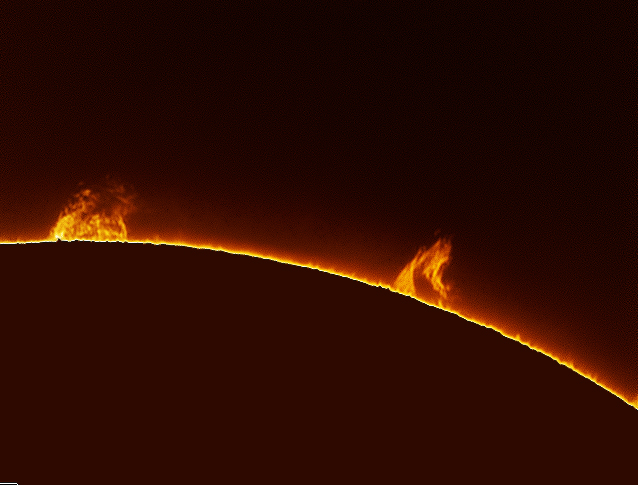
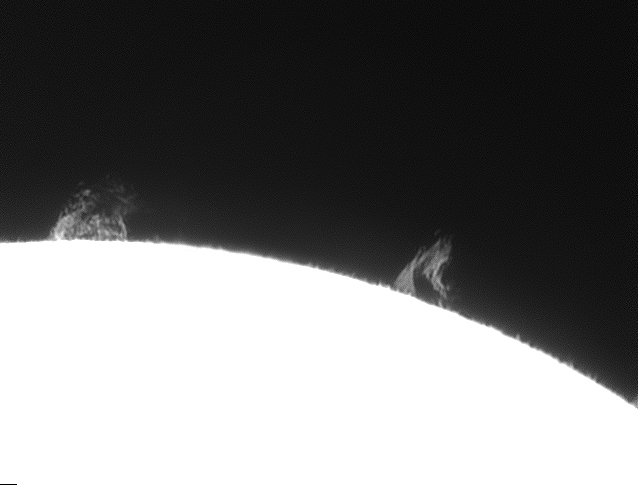
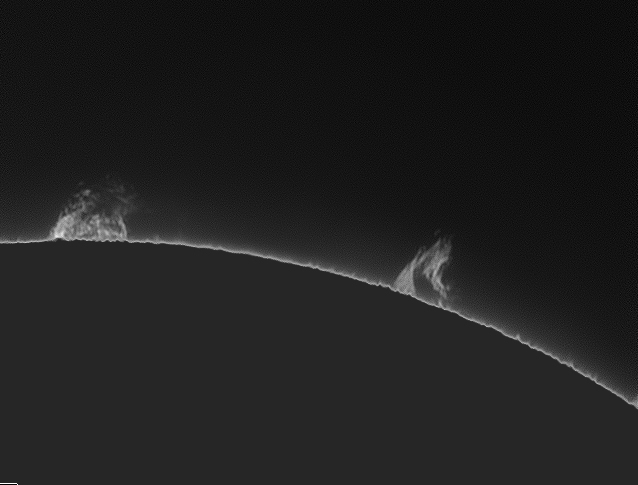
Solar disk - 27 June 2013
Here is the 'solar prominence' seen on the surface of the sun.. A small sunspot is there as well. Three different processing techniques to identify more detail.
Measuring the real size of a prominence
Lets start with an original image, no cropping no scaling. Below is the stack of 5 images (this is to keep the noise a bit down) from the raw AVI file i captured with an Imaging Source camera, DMK21. Posting this image on the web will change the actual size of the image but the original image is 640 * 480 pixels in size.
First we need to find the Imaging Scale of my setup. I am using Lunt 60 telescope which has an aperture of, you guessed it, 60mm. Next the focal length of this telescope is 500 mm. Dividing both numbers give us the f/ratio of 500/60= 8.33
I am also using a 2.5X barlow lens from televue (one of the best barlow lenses i have ever used). Now lets use this number.. but how?
Astronomy should be fun for those as well who hate maths! (I don't actually hate maths but would love to be lazy enough to allow a calculator doing all the hard work for me). So putting the numbers in CCD Calc, i see focal length becomes 1245 mm and f/ratio is gone at 21.
Each pixel in DMK21 has a measurement of 5.6 micro meter and this gives me an image scale of 0.93 arcsec/pixel. This means that every pixel on my chip is seeing 0.93 arcsecond of the sky (which is very very tiny, Our Sun or Moon you see in the sky is about 1,800 arcseconds is size).
Now i need to find out the area being covered in 0.93 arcseconds. This is also not difficult at all. One of the first formula astronomy students learn is called the small angle formula. This allows to calculate the original height of an object, if we know the angular size of the object and the distance between the observer and the object is known.
I used StarryNight software to see the distance the sun had yesterday at the time of imaging, which was 1.016391237 Astronomical Unit. This corresponds to 1.52049965*10^11 meters. So using the small angle formula, with my setup, 0.93 arecsecond here in this image is equal to 685 km!
To find the angular size of the whole prominence, i used Photoshop to count the pixels, see below:
I have marked the prominence in the yellow box to count the height and width of the whole area. On the right is a higher prominence which is marked with blue. After counting the pixels and multiplying it with per pixel area, here are the result.
The height of the highest point on earth is of Mount Everest, which is less than 9 km. Now you can see the highest part (right) of this prominence is more than three thousand and five hundred times of the height of Mount Everest! Imagine standing at the base of this prominence (lets call it a mountain of rising fire) and watching it rise that high in the sky.
The width is about 90,000 km.. this is more than double the length of the distance you would make if you travel the whole planet Earth through the equator.
Now look again on the top image.. how humble and small this prominence looks.. yes, looks can be deceptive.
Solar Disk - 25 June 2013
and here is a beautiful prominence making a loop on the solar disk.. again with variations of image processing. There is nothing else interesting on the disk currently.
Solar Prominences 25 June, 2013
Off i go.. with my new toys, i would like to keep myself busy so here is the first result, a solar prominence. There were very few proms around the solar disk and this i found out to be the best to start off my imaging tests with the new mount. Above are the three flavors of my processing routine. If i could get a hold of it, and the mount proved to have a really good tracking then i will also attempt animation of the proms which i used to do with my previous Losmandy Titan Mount.
New Celestron VX Mount
Celestron introduced their latest mount in January this year. The VX Mount is very light weight, portable and specially designed for imaging. It can track well past the meridian, has permanent PEC correction and with high torque motors it can handle some weight imbalances.
I bought this mount for its portability, light weight, very quick assembly and only for Lunt solar telescope. I received it in March and when setting it up for the first time, made a terrible mistake. With all my 'expert' confidence i attached the Dec cable in Aux port and... smoked the mount! The board was burnt in many places.
I had to sent it back to Celestron in USA. It took them a month to send it back. What they did was amazing indeed.. they replaced the faulty mount head with a brand new one and charged me absolutely nothing!
I have also got their Power Tank for portable power supply. I know Maroof will love it.
So now i am all ready for solar imaging.. Solar surface is changing all the time and i will make sure to capture it 'all' the time!
Why do the stars twinkle
This video not only has a beautiful view but also shows a very common phenomenon knows as 'twinkling' (Try HD viewing here). This is very well known with the stars we see in the night sky but this video is showing the street lights twinkling as well. The further they are the stronger is the effect.
So what is twinkling anyway.. my Oxford dictionary of Astronomy defines it this way:
The rapid fluctuations in brightness of stars, more properly known as scintillation. Twinkling is caused by atmospheric turbulence distorting the incoming wavefront from a star. Twinkling is less noticeable in planets, which have an extended area. Excessive twinkling is a sign of bad seeing.
A light ray not only changes its speed but it also bends its path when it moves from one medium to a different medium, which have different densities. The vertical rising air and the fast moving horizontal air in the atmosphere are constantly creating different pockets of various densities. Which in turns varies the refractive indices of different regions in the air. Here when and where the wavefront is convex, the light rays converge and where the wavefront is concave, the rays diverge. This concentrates and de-concentrates the energy of the wave in certain patches. Twinkling is born.
These changes begins in the high layers of earth's atmosphere and extends all the way down to the earth or inside your telescope tube and even on the surface of the mirror or lens.
So to keep the observatories more thermally balanced they now have windows like features in the domes' walls which are opened when needed. In my observatory, which has a roll off roof structure, i have tried various ways to make seeing as good as i can. Since it is on the roof top of my house which has bricks all over, in hot season, i sprinkle water on the roof when the sun goes down. In about two hours when i am ready to image, the evaporating water has already taken a lot of heat from the brick roof.
I have also tried multiple times to turn on a pedestal fan at various speeds in my observatory in the hope of getting the convection layers as low as possible but honestly i have not noticed any difference in my seeing, perhaps the structure of my observatory does not allow convection currents in the air to minimize this way. The other problem is the mount, at these high wind speeds and such a long focal lengths the mount does shake and the image degrades so the fan is not helpful for me.
Adaptive optics technology in the professional observatories helps a lot in minimizing the bad seeing.. these 'rubber optics' which can adjust according to the incoming wavefront are one of the key technological marvel that astronomers can really feel proud to have. Though my SBIG AO-8 is marketed as adaptive optics but in reality it does not have a bending optical instrument, rather it has a lens that can move on two axis at quite high speeds. It actually is a good guider than a bad seeing corrector device.
Coming back to this video, the far off street lights are traveling such a long distance that the varying densities of air, caused by the movement of hot air, are making them twinkle. The nearest lights are much less effected and show quite a stable sources of lights.. great view!
More halpha 3D processing
Today, two separate files were recorded, one for dim prominences and the other for bright solar disk. Among 7,000 frames, 1,500 were selected, aligned and stacked in AviStack; sharpened in Registax and combined and processed in Photoshop CS5.
Twitter Posts
I saw an option on squarespace which can be used to add twitter posts at my website. So i have added a page for my tweets here. I will be posting about my thoughts and activities in and out of my observatory but mainly for my telescopic observation and imaging. You can follow me here what i am upto with my equipment, my failures and my successes.
Sunspot 1598
There are three active sunspot region on the sun. Solar & Heliospheric Observatory (SOHO) is showing the following image right now:
Solar disk with sunspots (SOHO website)
I have got AVIs of all these three regions but the most interesting is 1598; it has a complex structure and is quite a big one. when compared with our earthly standards. Following are the images from my processing run or lets just say, "image ladder" AVI file contains many hundreds or thousands of images. Seeing allows both worst and good views to pass through the atmosphere. The image on right is the worst image in the AVI and on the left (traces of granulation) is the sharpest one.
And here is the comparison with our planet.. now you can truly see how big is this region when earth is put to scale here:
Sun today in halpha wavelength
Just got some videos from Imaging Source DMK21 camera and processed them.. This is happening on Sun today.
Telescope is back in the observatory
Shifting the monster is never easy.. and this is the only reason why i 'want' to avoid public sessions with my C14 and Titan mount but could never avoid to avoid this want.
An off day provided the opportunity to put back everything where it truly belongs.. i still have to figure out some cables issues and want to put back the main CCD setup at the telescope.
After attaching Lunt halpha telescope with the C14 OTA, i got a quick look at the sun.. and immediately saw a huge prominence where the arc was attached to the solar surface on both sides. I thought i must image it. So i installed imaging source DMK21 camera with this scope and carefully tuned the pressure tuner and focuser and quickly grabbed a few movies. Here are the results.. not bad!
Thandiani tour
So Thandiani was great.. so many people joined us from three different cities: Lahore, Islamabad and Abbottabad. I, on the behalf of Lahore Astronomical Society, am very thankful for those crazies who drove all the way up to the 9,000 feet high peak.
It is always nice to be up there.. i think i have been going there for fifteen years now and the main reason is that Thandiani has extremely raw night skies and it has a great scenic beauty; plus for us 'land dwellers', mountains always have very pleasant weather. The above shot is the morning view from my mobile camera, just a few yard away where we were staying.
Though we were struck by the astronomers' nightmare (clouds and a bit of rain), the sky did allow us to set our telescopes and watch clusters, binary stars and planets. Milkyway is always one of the best treats a good night sky can offer us.
I enjoyed meeting my old astro pal Saif Sahib from Islamabad and my new friend Asadullah from Abbottabad. We had a lot of time for our heavenly and earthly talks and everything in between.
I so wanted to image from Thandiani but this time clouds won.. Also, this time i did notice a considerable decline in the quality of night sky there.. It seems the nearby city Abbottabad is growing fast and in a few years we will definitely loose the advantage of a light pollution sky at Thandiani.
Thank you again everyone who came for our two nights observation session at the mountains.. more trips coming up..
KSS and Suparco collaboration on WSW
This afternoon Suparco and Khwarizmi Science Society made a wonderful public event at Gulshan Iqbal Park, Lahore. Water propelled rockets were just great! Telescopes, Seismograph, crater mkaing material, lunar phases, satellites models, introduction to space movies and many posters were being presented to the public.





